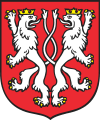Kąty Wrocławskie
| Kąty Wrocławskie | ||
|---|---|---|
|
Fragment of the town square | ||
| ||
 Kąty Wrocławskie | ||
| Coordinates: 51°2′N 16°46′E / 51.033°N 16.767°E | ||
| Country |
| |
| Voivodeship | Lower Silesian | |
| County | Wrocław | |
| Gmina | Kąty Wrocławskie | |
| Area | ||
| • Total | 6.35 km2 (2.45 sq mi) | |
| Elevation | 138 m (453 ft) | |
| Population (2006) | ||
| • Total | 5,418 | |
| • Density | 850/km2 (2,200/sq mi) | |
| Postal code | 55-080 | |
| Website | http://www.katywroclawskie.pl | |
Kąty Wrocławskie [ˈkɔntɨ vrɔt͡sˈwafskʲɛ] (German: Kanth) is a town in Wrocław County, Lower Silesian Voivodeship, in south-western Poland. It is the seat of the administrative district (gmina) called Gmina Kąty Wrocławskie. Prior to 1945 it was in Germany. (For more information about the history of the region, see Silesia.)
The town lies approximately 22 kilometres (14 mi) south-west of the regional capital Wrocław. The river Bystrzyca, a tributary of the Oder, flows through the town on the eastern side.
As of 2006, the town has a population of 5,418.
History
Middle Ages
In the Middle Ages, the region in which Kąty Wrocławskie is in today was inhabited by Silesian peoples. The town started existing in 1297, when Bolko I the Strict allowed the founding of the town using Silesian law. In 1298, records show that a town, named Kant was already established. In 1302, more records mention the presence of a hereditary vogt ruling over the town, as well as the existence of a parish in Kant—Saint Peter and Paul Parish.
In the first years of its existence, Kąty Wrocławskie was ruled by Wrocławian princes, and it was only until later that the town became fully sovereign.
In 1310, the town became a notable center of trade in the region. The success of the town was helped by the existence of a nearby ford in the river Bystrzyca. In 1322, the town was gifted to the daughter of the Henry VI the Good, who married Konrad I of Oleśnica, strengthening the towns ties with the Czechs.
In 1329, the town belonged to the princedom of Jawor-Swidnica, later coming under the control of the Duchy of Ziębice. In 1339, the duke Bolko II the Small sold the town to Konrad II the Gray. In 1449, Konrad IV the Older, in exchange for a loan, gave the town to the Bishop of Wrocław. Because the loan never got paid back, Kąty Wrocławskie became the property of the Diocese of Wrocław.
In the mid-fifteenth century, Hussites invaded and partially destroyed the town and its walls. Later in the century, a fire severely damaged the town.
External links
| Wikimedia Commons has media related to Kąty Wrocławskie. |
Coordinates: 51°02′N 16°46′E / 51.033°N 16.767°E


